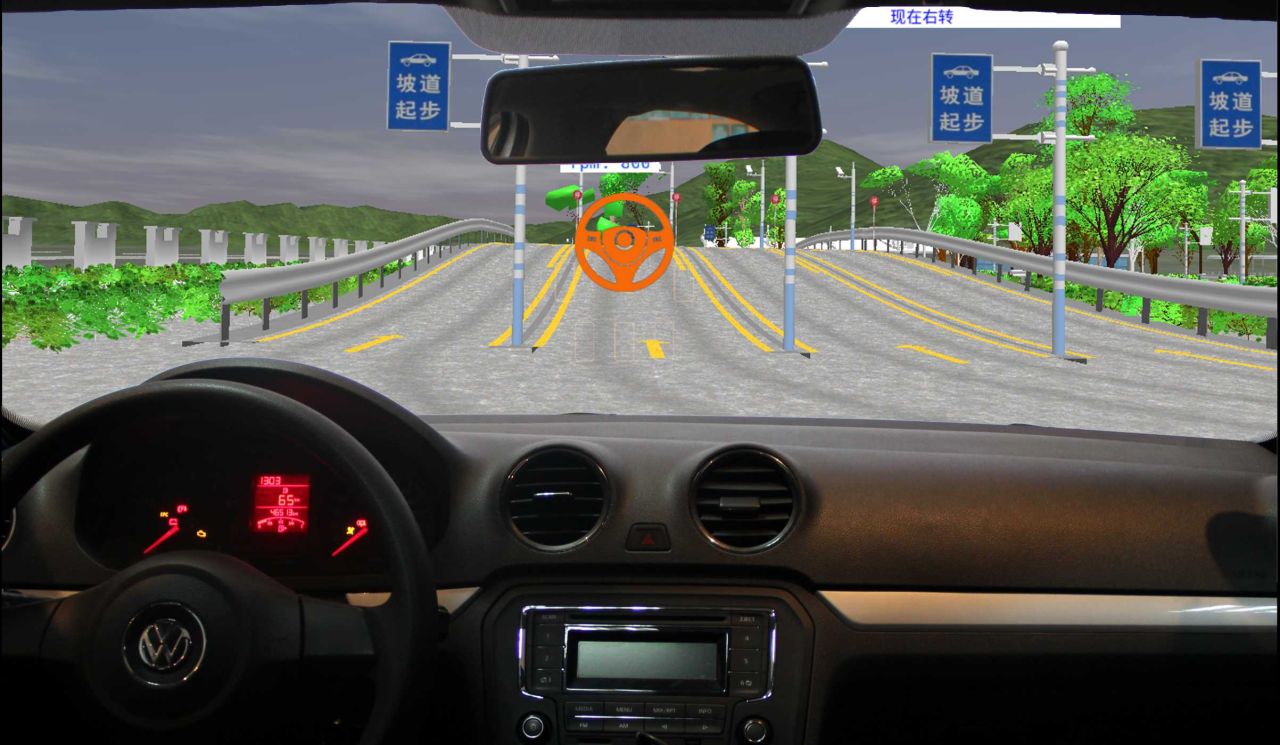Chinese driving schools are currently experiencing a strong demand, the number of learner drivers is growing constantly. A new type of driving simulator based on a car modified for virtual training of learner drivers in advance and an automatic feedback is to help meet this demand. For the close-to-reality driving exercises, complex projection technology and virtual-reality hardware and software are applied. The simulator was developed within the Driving Simulator (DriveSim) technology transfer project of KIT and Chinese partners.
For the driving training to be as close to reality as possible, a mid-sized car made in Germany and frequently applied in Chinese driving schools is turned into a driving simulator. The learner driver sits behind the steering wheel of a real vehicle without an engine and learns intuitive operation. “Modern vehicles are equipped with an internal network of actuators and sensors. Via this interface, a conventional vehicle can be turned into a driving simulator without changing its outer appearance,” Professor Jivka Ovtcharova, Head of the KIT Institute for Information Management in Engineering, says. Research of Ovtcharova, who is mechanical engineer and computer scientist, focuses on virtual engineering in all phases of IT support for innovative product development and production. The smart driving simulation system developed under her direction combines virtual reality with artificial intelligence and live maps, i.e. web-based map services. “Around 30 million people in China obtain the driver’s license every year. According to law, they have to pass a certain number of training lessons in the simulator,” Ovtcharova points out.
In the new type of driving simulator, all displays in the cockpit can be activated for real-time interaction: In case the driver moves the steering wheel, if he/she presses the pedal or changes the gear, the pressurized air system equipped with a special force feedback technology will ensure that road bumps or accelerations can be felt. “The learner drivers make their test drives in a virtual world that is based entirely on data of geoinformation systems,” Ovtcharova explains. For generating this environment, DriveSim uses virtual-reality projection technology. Viewing directions of the learner driver are tracked by an eye-tracking system and the environment is displayed at the correct angle. The learner driver is shown a three-dimensional artificial environment by projection onto a wall in front of the vehicle and three monitors for the rear-view mirrors. In this way, changing driving environments can be generated, such as roads in the neighborhood known to the learner, but also different traffic situations, weather conditions, and road surface properties.
The role of a virtual driving instructor is taken over by an intelligent tutoring system. It displays information on e.g. the driving speed in the projection, points out hazards, identifies driving mistakes, and assesses the driving behavior of the learner in order to document his/her individual progress. The real driving instructor can use this assessment to configure new driving exercises adapted to the driving skills learned.
A Chinese engineer who visited KIT, his former education institution, with a delegation in summer 2016, very quickly realized the market potential of KIT’s software development that is now used as a basis of DriveSim. “Within five minutes, he wanted to turn it into a product together with us,” Ovtcharova remembers. In September 2016, the two-year development project with the industry partner tuobaba Technology (TBB) started at Hangzhou, a city located 200 km southwest of Shanghai. Another cooperation partner is the Jiangyin Sino-German Technology Transfer Center. Development of the hardware configuration for the driving simulator is coordinated by KIT, the software solution is designed by KIT alone. The Chinese partners among others establish the necessary server infrastructure and will be responsible for remote maintenance of the driving simulators. “DriveSim is a pioneer project of German-Chinese technology transfer at KIT,” Ovtcharova says.
“Apart from research and education, innovation is one of the three core tasks of KIT,” emphasizes Professor Thomas Hirth, KIT Vice President for Innovation and International Affairs. “The DriveSim project is an example of how innovation can be achieved by product-oriented development from fundamental research to commercialization in cooperation with an industry partner.” The DriveSim project is supported by KIT’s Innovation Management Service Unit within a program for the transfer of product-oriented research results of market-relevant potential to industry through joint cooperation projects as well as cooperation and license agreements.
Click here for the project video (in German with Chinese subtitles):
https://www.youtube.com/watch?v=1fbaqa03WkA
Read more on the project website:
http://www.imi.kit.edu/english/46_3195.php
Read more on innovation management at KIT:
http://www.innovation.kit.edu/ima.php (in German only).
More about the KIT Information · Systems · Technologies Center: http://www.kcist.kit.edu
In close partnership with society, KIT develops solutions for urgent challenges – from climate change, energy transition and sustainable use of natural resources to artificial intelligence, sovereignty and an aging population. As The University in the Helmholtz Association, KIT unites scientific excellence from insight to application-driven research under one roof – and is thus in a unique position to drive this transformation. As a University of Excellence, KIT offers its more than 10,000 employees and 22,800 students outstanding opportunities to shape a sustainable and resilient future. KIT – Science for Impact.

